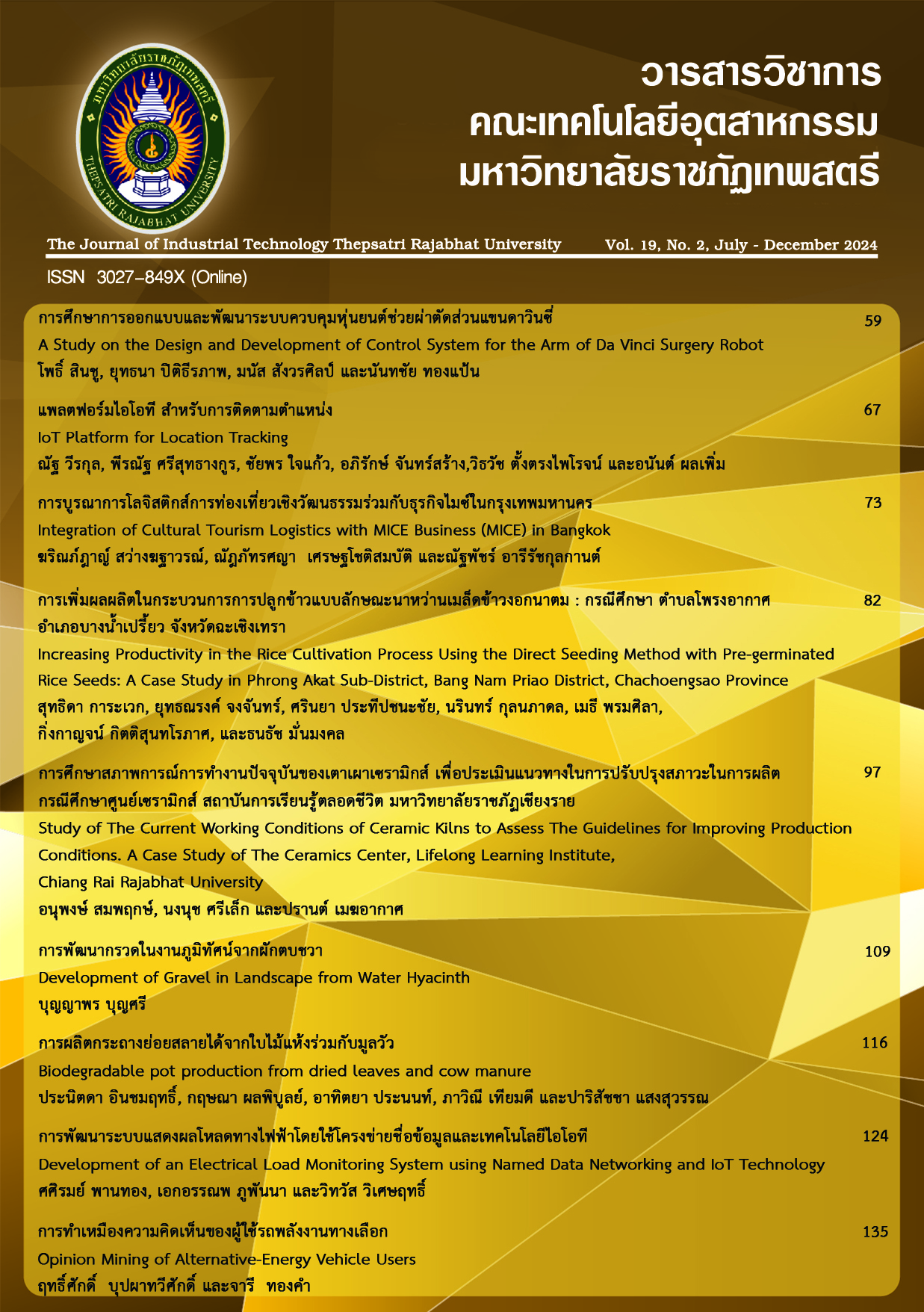การศึกษาสภาพการณ์การทำงานปัจจุบันของเตาเผาเซรามิกส์ กรณีศึกษาศูนย์เซรามิกส์ สถาบันการเรียนรู้ตลอดชีวิต มหาวิทยาลัยราชภัฏเชียงราย
Abstract
การศึกษาสภาพการณ์การทำงานปัจจุบันของเตาเผาเซรามิกส์ กรณีศึกษาศูนย์เซรามิกส์ สถาบันการเรียนรู้ตลอดชีวิต มหาวิทยาลัยราชภัฏเชียงราย เป็นการศึกษาขั้นตอนการผลิตและวิเคราะห์กระบวนการเผาผลิตภัณฑ์ โดยได้ศึกษาการกระบวนการเผาผลิตภัณฑ์จากเตาเผาที่ใช้ก๊าซแอลพีจีเป็นเชื้อเพลิง เพื่อนำผลการศึกษาที่มาจัดทำแนวทางในการพัฒนาและปรับปรุงกระบวนการเผาผลิตภัณฑ์เซรามิกส์ให้มีประสิทธิภาพ ลดปริมาณความเสียหายของผลิตภัณฑ์ เช่น การควบคุมอุณหภูมิภายในเตาตลอดระยะเวลาการผลิต (Working temperature) การเพิ่มขึ้นของอุณหภูมิ (Heating rate) ที่เหมาะสม จำนวนหรือปริมาณที่เหมาะสมของชิ้นงานที่จะเข้าสู่เตา (Samples) การเผาไหม้ที่เหมาะสม จากการศึกษาพบว่า การเผาดิบ ต้องระมัดระวังในการเพิ่มอุณหภูมิการเผาอย่างช้าๆ เพื่อลดอัตราการเสียหายของผลิตภัณฑ์ การเผาเคลือบ พบว่า มีปัญหาในการควบคุมการเปลี่ยนแปลงของสีเขียนใต้เคลือบที่ซีดจางลงหลังจากการเผา ในขั้นตอนการเผาเคลือบมีความสัมพันธ์ระหว่างอุณหภูมิและเวลาที่ y=106.45x+124.43 ใช้เวลาไปทั้งหมดที่ 12 hour ทำให้อุณหภูมิที่จบอยู่ที่ 1,225 °C แล้วจึงทำการหยุดให้ความร้อน และปล่อยให้เย็นตัวลงอย่างช้าๆ มีค่าความผันแปรของตัวแปรของความสัมพันธ์ของอุณหภูมิและเวลา (R2) มีค่าอยู่ที่ 0.964 การวิเคราะห์ก๊าซไอเสียจากเตาเผาเคลือบ พบว่า มีปริมาณร้อยละก๊าซออกซิเจน (%V) เท่ากับ 18.8 17.1 และ13.5 ร้อยละก๊าซคาร์บอนไดออกไซด์ (%V) 1.2 2.2 และ 4.2 มีปริมาณอากาศเกิน (%) 856.1 432.7 และ 180.8 ความเข้มข้นก๊าซคาร์บอน มอนอกไซด์ (ppm) 114.0 147.0 และ 6.0 การสูญเสียจากการเผาไหม้ (%) 62.8 65.5 และ 59.2 ประสิทธิภาพการเผาไหม้ (%) 37.2 34.5 และ 40.8 ตามลำดับ
References
K. Srijun, S. Yawiraj and S. Infang, “The Development of Marketing Mix Based on Customers’s needs for Ceramics Entrepreneurs in Upper North Thailand,” Payap University Journal, vol. 28, no. 1, pp. 57-70. Jan.-Jun. 2018.
J. Phongsaksri, “Ceramic Product Design Process,” Industrial Technology Journal, vol. 4, no. 3, pp. 58-67. Sep.-Dec. 2019 (in Thai).
W. Thanakorn. CERAMICS: Kiln and Firing Technique. Bangkok: Mr. Copy. 2010. (in Thai).
Ran4U, Firing Technique and Kiln. [Online]. Available: https://kiln.ran4u.com. [Accessed: Aug. 29, 2024]. (in Thai).
Cerawan, Cerawan Website: Information and Knowledge on Ceramics. [Online]. [Cited August 29, 2024]. Available: https://www.ce-rawan.com. (in Thai).
Ceramic Online, Types of Ceramic Glazes. [Online]. [Cited August 29, 2024]. Available: http://www.xn--12cgu2gjw3fra7hh3g.net/artic/ประเภทของน้ำเคลือบเซรามิก. (in Thai).
P. Y. Hsieh, “Effects of temperature non‐uniformity and effective viscosity on pyrometric cone deformation,” international journal of ceramic engineering and science, vol. 1, no. 4, pp. 216–226, Oct. 2019, doi: https://doi.org/10.1002/ces2.10026.
T. Pradell and J. Molera. “Ceramic technology. How to characterise ceramic glazes,” Archaeological and Anthropological Sciences, vol. 12, no. 8, Jul. 2020, doi: https://doi.org/10.1007/s12520-020-01136-9.
E. Abubakar, S. Mbidomti, M. Lawan, and N. Abubakar, “Evaluating the combustion process of methane fired cross draft ceramic kiln for efficiency and sustainability,” Sustinere, vol. 7, no. 1, pp. 27–38, Apr. 2023, doi: https://doi.org/10.22515/sustinerejes.v7i1.284.
Pollution Control Department, “Announ-cement of the Pollution Control Department,” Sep. 26, 2018. (in Thai).
S. Gordin, I. Zaychenko, V. Sokolova and V. Bazheryanu. (2021). “To calculate heat losses with flue gases of coal-fired boilers,” In E3S Web of Conferences (Vol. 285, p. 07028). EDP Sciences.
S. A. Hussnain, M. Farooq, M. Amjad, F. Riaz, Z. U. R. Tahir, M. Sultan and A. Bokhari (2021). “Thermal analysis and energy efficiency improvements in tunnel kiln for sustainable environment,” Processes, 9(9), 1629.
L. Montorsi and D Pasquale. (2015). “Energy and exergy analysis of an industrial tunnel kiln used in ceramic production,” Applied Thermal Engineering, 82, 1-9.
G. Battista and F. Fantozzi. “Wood fuel combustion and atmospheric emissions from ceramic production,” Environmental Science and Technology, vol.44, no.19, pp.7506-7566,2010 44(19), 7560-7566.
Department of Alternative Energy Development and Efficiency, Ministry of Energy, “Energy Manager Manual (Factory) B.E. 2560, Part 3, Chapter 1: Energy Conservation for Industrial Furnace,” 2017 (in Thai).

